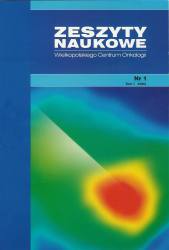Abstract
Breast cancer is the most common cancer in women. Radiotherapy is a very important part of the treatment of this cancer. As breast cancer patients survive longer, any long-term side effects caused by treatment become increasingly important. The aim of this study is to determine whether deep breath-hold (DIBH) respiratory-gated radiotherapy is superior to free-breathing (FB) radiotherapy in reducing cardiac exposure. The analysis included 50 patients treated in 2022-2023 for left breast cancer who underwent breast-conserving surgery. The obtained data allow us to conclude that DIBH is a more advantageous technique than FB. There is a visible decrease in the average dose to the heart from 3.29±1.77Gy to 1.43±0.54Gy, V20 to the heart from 5.14±4.95% to 0.67±0.81% in favor of DIBH. A slightly smaller difference, but still supporting the DIBH technique, is for the doses received by the left lung, i.e. a decrease in the average value from 7.39±2.21Gy to 7.14±1.9Gy, and in V20 from 15.42±5.17 % to 14.55±3.92%.
References
Bartlett, Frederick R., et al. "Voluntary breath-hold technique for reducing heart dose in left breast radiotherapy." JoVE (Journal of Visualized Experiments) 89 (2014): e51578.
Darby, Sarah C., et al. "Risk of ischemic heart disease in women after radiotherapy for breast cancer." New England Journal of Medicine 368.11 (2013): 987-998.
Early Breast Cancer Trialists' Collaborative Group. "Effect of radiotherapy after breast-conserving surgery on 10-year recurrence and 15-year breast cancer death: meta-analysis of individual patient data for 10 801 women in 17 randomised trials." The Lancet 378.9804 (2011): 1707-1716.
Whelan, Timothy J., et al. "Does locoregional radiation therapy improve survival in breast cancer: a meta-analysis." Database of Abstracts of Reviews of Effects (DARE): Quality-assessed Reviews [Internet]. Centre for Reviews and Dissemination (UK), 2000.
Latty, Drew, et al. "Review of deep inspiration breath‐hold techniques for the treatment of breast cancer." Journal of medical radiation sciences 62.1 (2015): 74-81.
Pedersen, Anders N., et al. "Breathing adapted radiotherapy of breast cancer: reduction of cardiac and pulmonary doses using voluntary inspiration breath-hold." Radiotherapy and oncology 72.1 (2004): 53-60.
Bartlett, Frederick R., et al. "Voluntary breath-hold technique for reducing heart dose in left breast radiotherapy." JoVE (Journal of Visualized Experiments) 89 (2014): e51578.
Malicki, Julian, and Krzysztof Ślosarek. Planowanie leczenia i dozymetria w radioterapii (Tom 2). VM Media Sp. z oo VM Group Sp. k. Grupa Via Medica, 2018.
Borgonovo, Giulia, et al. "Deep inspiration breath hold in post-operative radiotherapy for right breast cancer: a retrospective analysis." reports of practical Oncology and radiotherapy 27.4 (2022): 717-723.

This work is licensed under a Creative Commons Attribution-NoDerivatives 4.0 International License.
Copyright (c) 2024 Letters in Oncology Science
